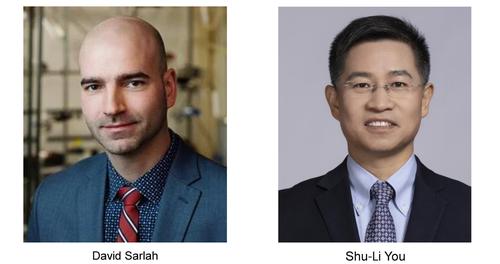Advanced Synthesis & Catalysis ( IF 4.4 ) Pub Date : 2024-10-26 , DOI: 10.1002/adsc.202401218 David Sarlah, Shu‐Li You

|
 When it comes to small organic molecules, aromatic compounds are considered to be one of the most abundant and versatile building blocks, currently produced on a hundred million metric ton scale each year. Moreover, due to their inherent resonance stabilization, arenes have been fascinating scientists for nearly two centuries and have also been serving as a never-ending inspiration for synthetic chemists. Arenes are in their own class of chemistry based on many unique reactivities that are associated only with this type of compounds. One such characteristic transformation is dearomatization – a type of reaction that can overcome aromatic stabilization and convert arenes into saturated, nonaromatic compounds. Historically, these transformations were limited to dearomative hydrogenations, dissolving metal reductions (Birch reaction), and oxidation of phenols; however, during the last couple of decades, the field has witnessed the exponential increase of novel dearomative strategies and fundamental advances in the field. Driven by the pressing need in medicinal and natural products chemistry to produce molecules with a dense array of functionality, increasing saturation (sp3 content), and different spiro- and polycyclic motifs, dearomatizations have become a platform to provide many solutions at the frontline of synthetic chemistry and molecular sciences. Incorporating advances and recent reactivity paradigms in catalysis, photochemistry, heterocyclic chemistry, electrochemistry, and biocatalysis, has led to a plethora of dearomative methods that have greatly expanded the scope and complexity of building blocks accessible from simple arenes. These include the enantioselective variants by employing strategies of asymmetric catalysis into the dearomatization processes.
When it comes to small organic molecules, aromatic compounds are considered to be one of the most abundant and versatile building blocks, currently produced on a hundred million metric ton scale each year. Moreover, due to their inherent resonance stabilization, arenes have been fascinating scientists for nearly two centuries and have also been serving as a never-ending inspiration for synthetic chemists. Arenes are in their own class of chemistry based on many unique reactivities that are associated only with this type of compounds. One such characteristic transformation is dearomatization – a type of reaction that can overcome aromatic stabilization and convert arenes into saturated, nonaromatic compounds. Historically, these transformations were limited to dearomative hydrogenations, dissolving metal reductions (Birch reaction), and oxidation of phenols; however, during the last couple of decades, the field has witnessed the exponential increase of novel dearomative strategies and fundamental advances in the field. Driven by the pressing need in medicinal and natural products chemistry to produce molecules with a dense array of functionality, increasing saturation (sp3 content), and different spiro- and polycyclic motifs, dearomatizations have become a platform to provide many solutions at the frontline of synthetic chemistry and molecular sciences. Incorporating advances and recent reactivity paradigms in catalysis, photochemistry, heterocyclic chemistry, electrochemistry, and biocatalysis, has led to a plethora of dearomative methods that have greatly expanded the scope and complexity of building blocks accessible from simple arenes. These include the enantioselective variants by employing strategies of asymmetric catalysis into the dearomatization processes.
This issue offers a unique glimpse into the current state of the art of dearomatization chemistry. We thank the authors for their valuable contributions, which showcase how these transformations deliver unique molecular disconnections and products, provide one of the most rapid complexity-generating strategies in organic synthesis, and will continue to inspire us for years to come.
中文翻译:

脱芳烃化学的现状
![]() 当谈到有机小分子时,芳香族化合物被认为是最丰富和用途最广泛的组成部分之一,目前每年生产一亿公吨。此外,由于其固有的共振稳定性,芳烃在近两个世纪以来一直是令人着迷的科学家,也一直是合成化学家永无止境的灵感来源。芳烃属于自己的化学类别,基于许多仅与此类化合物相关的独特反应性。其中一种特征转化是脱芳烃化——一种可以克服芳烃稳定并将芳烃转化为饱和的非芳烃化合物的反应。从历史上看,这些转化仅限于脱氢、溶解金属还原(Birch 反应)和酚类的氧化;然而,在过去的几十年里,该领域见证了新型 Dearomative 策略的指数级增长和该领域的基本进步。在医药和天然产物化学的迫切需求推动下,生产具有密集功能、增加饱和度(sp3 含量)和不同螺状和多环基序的分子,脱芳烃已成为在合成化学和分子科学前沿提供许多解决方案的平台。结合催化、光化学、杂环化学、电化学和生物催化领域的进步和最近的反应范式,导致了大量的脱藻方法,这些方法极大地扩展了可从简单芳烃进入的构建单元的范围和复杂性。 这些包括通过在脱芳烃化过程中采用不对称催化策略的对映选择性变体。
当谈到有机小分子时,芳香族化合物被认为是最丰富和用途最广泛的组成部分之一,目前每年生产一亿公吨。此外,由于其固有的共振稳定性,芳烃在近两个世纪以来一直是令人着迷的科学家,也一直是合成化学家永无止境的灵感来源。芳烃属于自己的化学类别,基于许多仅与此类化合物相关的独特反应性。其中一种特征转化是脱芳烃化——一种可以克服芳烃稳定并将芳烃转化为饱和的非芳烃化合物的反应。从历史上看,这些转化仅限于脱氢、溶解金属还原(Birch 反应)和酚类的氧化;然而,在过去的几十年里,该领域见证了新型 Dearomative 策略的指数级增长和该领域的基本进步。在医药和天然产物化学的迫切需求推动下,生产具有密集功能、增加饱和度(sp3 含量)和不同螺状和多环基序的分子,脱芳烃已成为在合成化学和分子科学前沿提供许多解决方案的平台。结合催化、光化学、杂环化学、电化学和生物催化领域的进步和最近的反应范式,导致了大量的脱藻方法,这些方法极大地扩展了可从简单芳烃进入的构建单元的范围和复杂性。 这些包括通过在脱芳烃化过程中采用不对称催化策略的对映选择性变体。
本期提供了对脱芳烃化学当前技术水平的独特一瞥。我们感谢作者的宝贵贡献,这些贡献展示了这些转化如何提供独特的分子断开和产物,提供有机合成中最快速的复杂性生成策略之一,并将在未来几年继续激励我们。


















































 京公网安备 11010802027423号
京公网安备 11010802027423号